I think that Branden has successfully finished the last big transfer likely to cause blog hiccups. So I think we can safely move over to the new website entirely now. See you over there!
(www.desigknit.com, in case the link doesn't work for you)
Thursday, December 17, 2009
Let's make this official, shall we?
Posted by
EGunn
at
4:41 PM
![]()
Wednesday, December 9, 2009
Welcome to winter
When we put our things in storage this summer, we thought about the fact that we might be moving them out of storage in the snow. We were pushing our luck trying for a December 1st move in the upper midwest.
We got lucky: there wasn't any snow, and it wasn't even very cold. Perfect conditions for a move, actually.
Last weekend we got a dusting of snow, which then built up to about 4 inches over a couple of days. Everything was pretty and white, and it seemed like a good way to ease into the winter.
And then last night, the rest of it came.
Say hello to winter!
It took three of us 2 and a half hours to clear the driveway this morning, even with a snowblower. I haven't heard official numbers, but there is a lot of snow out there.

Posted by
EGunn
at
7:43 AM
|
![]()
Sunday, December 6, 2009
Where were we?
The unpacking is mostly finished, and I'm beginning the process of figuring out where everything is, and where it now belongs. In that spirit, how about a project update?
Though it hasn't gotten much blog time, the Kauni sweater is moving along nicely. Here's where it was just before we left Germany:
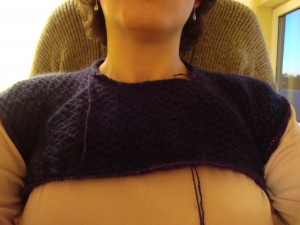
The armholes are joined, and I'm working my way down the body. This was my only plane knitting, so it's a bit further along now than it was in this photo. I haven't touched it since we landed, but I'm looking forward to getting back to it soon. It's so nice that it's back to only 400 stitches a round! (It was at almost 700 before the split, and those rounds were taking a really long time...)
In the week before we left, I re-knit the red scarf with a garter edge, and I turned the pattern sideways. I had hoped that this would help it to lay flat, as all of the curling had been at the long edges in the first version. Unfortunately, the sideways scarf did the same thing:
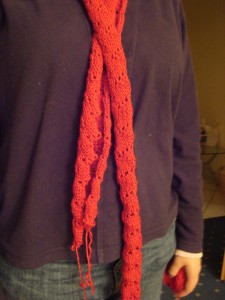
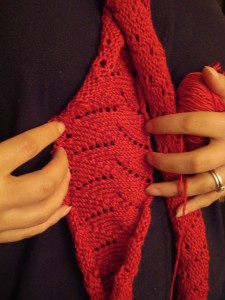
I also tried using a bigger needle, as Ellen suggested in the comments. The first scarf was knit on a 5; I moved up as far as a 9 and was still getting curling. In this case, I don't think it was the stitch pattern; it was the weight of the yarn pulling it into its cinnamon-stick shape.
I pulled the whole thing out and gave away the yarn instead of packing it. It will make a beautiful bag or something, knit up in a design that doesn't want a lot of stretch and that can bear a little weight. It just wasn't the right yarn for my purposes.
I had a little bit of SouthWest Trading Company bamboo in red waiting for me in my US stash, so I put the scarf aside until we came back here. Unfortunately, I didn't have as much as I remembered, and the yarn is old enough that it doesn't quite match the current colorway. Given the microfiber experience, I was also a little worried that the weight of a 100% bamboo yarn would cause the same problems with curl. Instead, I found some beautiful Frog Tree fingering weight alpaca (color 23) at my new LYS. This yarn is light and airy, much warmer than the microfiber, and has a beautiful halo. I wasn't sure how I'd like the pattern in a fuzzy yarn, since the clear stitch definition was my favorite thing about the microfiber version. And then I started knitting.
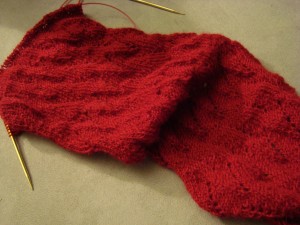
I cast on Thursday night, after realizing that I hadn't knit in almost a week. I haven't had much time for it since then, but it's flying off the needles, especially considering that Ifrogged back a good 12 inches when I discovered that I'd made errors setting up the stitch pattern.
I can't believe how much better it is. It doesn't have the same crisp stitch definition, but the alpaca yarn has a beautiful softness, and I love the way it catches the light. I tried for about an hour to get a good photo earlier, but I couldn't really get the new camera to capture it. I forsee some trial and error photoshoots in my future, as I learn the buttons and settings for this new camera.
We also visited another of Madison's yarn shops, looking for yarn for a second scarf. We didn't find the perfect color, but I love the one that we did find:
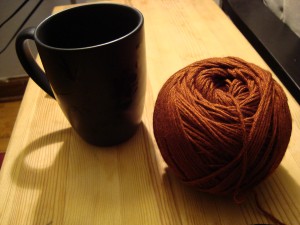
That's a silk-merino blend by Cascade called Venezia (color 160 - Ginger). I don't think I've ever seen Venezia before, but it's a beautiful yarn. The shine and the feel are perfect, even though there wasn't much available in the exact burnt-orange color that I was hoping for. I'm a little worried that I won't have enough yarn (it's only 160 yards), but I have a tendency to over-buy for projects, so I'm hoping that I'm overestimating what I'll need. There was plenty in the store, so I can go back for more if necessary.
My only complaint with the yarn is that there were three or four damaged areas in the skein that I didn't find until winding it into a ball. Cascade is usually better quality than that, so I'm hoping that it's just a fluke, because I think I'm very likely to knit with this again.
I'm not really sure yet what stitch pattern to use for this scarf. It should be a little bit more muted to match this other friends' personality, fairly open (to help with yardage, mostly), and something that really shows off the shine and drape of the yarn. Nothing has popped out of the Walker books yet, but we have another date this evening.
The waving lace pattern is also coming along well. I have one more chart section that needs to be test knit (for the last time, I hope!), a few stitch counts to calculate/verify, and then it's all layout, proofing, and editing.
And, last but not least, the geometric lace project is also coming along well. I couldn't get a good picture of the swatch tonight, so I'll have to show it to you later. One transition is completely mapped out, and it's waiting until I have some quiet time to focus on the other.
So there's the knitting status. I was thinking of writing a "State of the Stash" post, but that will have to wait for another day, when I'm up to a project of that magnitude. For now, I'm just glad to be able to find time to knit.
Posted by
EGunn
at
6:15 PM
|
![]()
Monday, November 30, 2009
Monday, November 23, 2009
Transitions
Flight date is fast approaching, and this has been a week of lasts. Last knitting meeting, last dinner with friends, last time grocery shopping in Germany, last this and last that. Closing up one life, preparing to move on to the next.
That might be part of the reason that I'm enjoying working out transitions in lace, finding one design that flows seamlessly and beautifully into the next.
In the waving lace shawl, I created the knitting and then began to chart and plan the pattern. I reknit the piece to make sure that the new plans would work. I have charted and swatched and charted again, tweaking and reinventing each time. It's almost done, but there is still some swatching left to do. When I began, I didn't know what I would need for the pattern. Working through the process has helped me to see what I will need at each stage, and how to set up a project so that it leads into a pattern with a little less reworking along the way. It's slow going, but I have learned a lot.
The transitions are the most important part, and they're the part that I knit most intuitively. I don't usually plan them; I knit until I get there, and then see what makes sense with the stitches as they sit on my needles. Sometimes I take notes, but they're not usually very thorough; more like a secret, cryptic code for myself than a set of clear instructions for someone else to follow.
This time, I am working on making those instructions more explicit the first time, in the swatching stage. This time, the first knit piece will be the test piece. This means that there's a lot more up-front planning involved.
I started out with the wave pattern that I showed you last time:
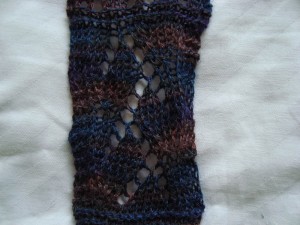
This pattern comes from the Walker books as an allover pattern, whose repeat begins at the center "stem" of the vine. But I want a single vine running down a knit panel.
I switched to a thicker yarn for this swatching, since I wanted better stitch definition than the dark laceweight could provide. No sense going blind trying to count stitches and remember where I put the decreases. I couldn't find my normal swatching yarn, so I used the red scarf yarn. First, I recharted the lace with one repeat in the center. In the allover pattern, the yo's bordering one vine feed into the next motif, creating its leaves. I replaced those extra yarnovers with make-one stitches, so that I would have just one vine on a solid background.
The vine pattern works by having yarnovers separated from decreases across the entire fabric, which causes the lace to widen and narrow as it's knit. In an allover fabric, this doesn't make much difference, as the width of one repeat compensates for the narrowness of another. In a single-repeat panel, though, it makes for wavy edges.
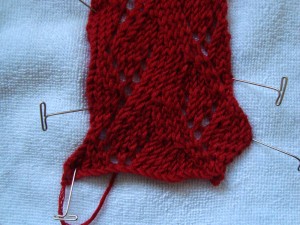
The first repeat (at the bottom) is knit in the pattern as given: the right-hand side bulges out, and the left-hand side dents in. After working that one repeat, I began eliminating make-one stitches and the corresponding decrease stitches so that the edges would stay straight.
This gave me the single vine that I wanted, but it also caused the whole pattern to shift over one stitch with every repeat, which wasn't exactly the effect I'd hoped for. I wanted a panel that went straight, not one that moved over one stitch every twelve rows. I fussed, I recharted, I fussed again. I counted stitches, I compared with the original pattern. It still translated over one stitch.
Eventually, I gave up on my charted version and decided to start again from scratch. I studied the way the increases and decreases worked together, and figured that I knew enough to just rewrite the whole thing. One thing I noticed was that there was a set of staggered decreases on each side of the vine, and that they were separated by four stitches running down the middle of the panel. I wanted a narrower piece anyway, and I couldn't see what they could possibly be good for, so I simply eliminated them.
As often happens, too much planning and analysis took the spontaneous, organic curves out of the design.
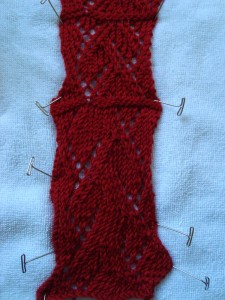
The part knit above the garter stitch separator is very similar to the first, and much narrower (just as I'd wanted), but it's missing the undulating curves that made this pattern interesting to begin with. The curves are a product of those four seemingly useless stitches that do nothing except run up the center of the piece, leaning left and right as the fabric around them increases and decreases. They're also a product of decreases worked on a different spacing than the increases. This didn't make sense to me, so I'd put the increases and decreases parallel to one another, and I'd lost the flow. Maybe I didn't understand this stitch pattern as well as I thought I did.
I went back to the beginning, and started over. I began with the original pattern, changed to solid increases, eliminated the wavy edges, following the same set of steps as before. This time, I paid more attention to the waves, and figured out that I'd added an extra yarnover while trying to force the pattern to follow lines too rigidly.
Now that the vines were cooperating, it was time to start working on the blocks. I'd found my swatching yarn and so I turned back to wool, which is a lot easier to work with. Again, I charted. Again, I got it wrong the first time (but only partially).I went back to the swatch and felt my way through it, ending up with this:
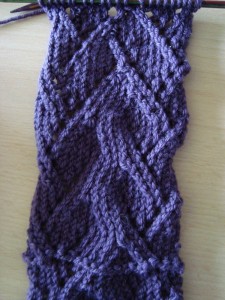
At the bottom, curvy vines. At the top, angular blocks. (Sorry for the horrible lighting...it's definitely November around here, and it's hard to get a good picture, even at noontime...)
And so it goes. Chart, swatch, chart. Analyze, overshoot, correct, try again. Correct the corrections, create the final chart.
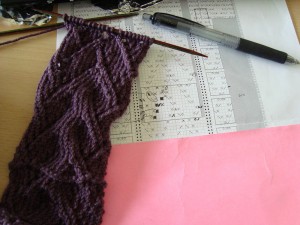
Posted by
EGunn
at
11:12 AM
|
![]()
Thursday, November 19, 2009
Sketch of a project
In between pattern writing and knitting, I've been poking around in the stitch dictionaries, looking for my next big lace project. I usually start brainstorming around one central pattern, and then try to find others that work with it, gradually feeling my way outward from that one central point. I mentioned before that I'm drawn to geometric patterns right now, I've had my eye on this one for a while:
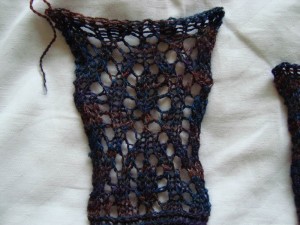
It's called pendants lace, and I love it. With more repeats, the two motifs interlock like little puzzle pieces. (It's very obvious in the Walker photo, not so obvious in my swatch. I wanted to use the Walker pictures in this post, but I'm not sure if that's Fair Use as far as copyright is concerned. Trust me, the two motifs interlock like little puzzle pieces....) My second trip to the stitch dictionaries focused around this one stitch pattern. What could I find that would match?
It's a complicated motif, and a pretty unusual one. There weren't many partners stepping up. But then I found myself coming back to this again and again:
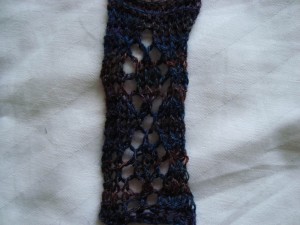
The motif looks a lot like the pendants in the pendant lace.
Then I looked for things that matched the slanted yo lines in the pendant lace.
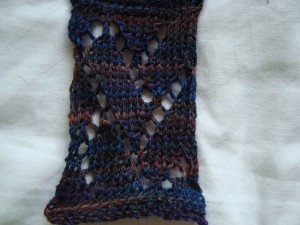
And for something to soften it.
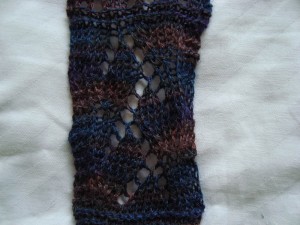
I added a wavy edging to go with the vines.
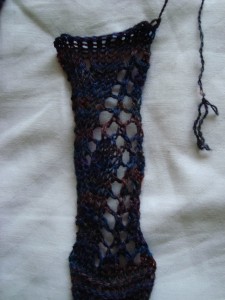
All of a sudden, I had my transition from rigid, geometric pattern to soft, undulating vines.
So, I swatched. I'm planning to use the Mountain Colors Winter Lace that Branden brought back from the U.S. in September. It's a 50/50 Merino/Silk mix, and it's beautiful. It's a real laceweight, so it's light enough to knit into a fairly solid fabric, and it's a generous skein that should last through a fairly dense lace project. These photos are a little bit dark, but they give you a pretty good idea of the colors.
And now, all that remains is figuring out how to put them together...
Posted by
EGunn
at
12:12 PM
|
![]()
Wednesday, November 18, 2009
I think I've got it
One last post about waving lace joins, and then I'm done. Promise.
Last time, I showed you the new join. It looked pretty good. The extra openwork columns gave the lace a little more room to stretch, so there was less necking.
But the tip wasn't quite right. I'd knit this version by finishing up the last pattern row of the waving lace, purling back (the usual reverse side), and then beginning the openwork. That left two horizontal bars just above the tip (far left image, below). These two bars disrupted the usual pattern of diagonal lines in the openwork, and they were bothering me.
After sitting and poking at the swatch for a while, I realized that the horizontal bars were from the purl row, where the yarn is carried between the stitches. Once I realized that, I moved both yo's into the "purl back" row, beginning the openwork immediately after the pattern repeat ends. This gave me the same even look for both columns, and started the openwork right away, eliminating the extra bars (far right image). It might be a picky detail, but I like it a lot better. I'm always amazed at how small things can make such a big difference in lace, and how important each stitch is to the overall pattern.
And now, back to charting.
Posted by
EGunn
at
5:57 AM
|
![]()
Monday, November 16, 2009
Why math is beautiful
There are lots of reasons that math is beautiful. Branden sent me this one today. Go look; you'll be glad you did.
Is it a bad thing that all I see is lace?
And, might that be crochet?
Posted by
EGunn
at
7:51 AM
|
![]()
You know what you have to do
Sometimes you just know that a project isn't working. Sometimes you keep knitting anyway, in the hopes that your "fix" will work.
Sometimes it doesn't.
Really, I've known since I finished the first skein (of four) that the gift scarf isn't going to work out. I kept telling myself that the nagging "not working" feeling was because I didn't like the yarn (I don't), or maybe because it's just not my color (it isn't). I reminded myself that this isn't for me, and that the recipient and I have very different tastes in just about everything. That didn't make the nagging any quieter. After finishing the first skein, I noticed that the edges of the scarf were beginning to roll. I didn't like that, but I figured it would come out with blocking. So, I blocked it on the needles. Twice. Still curled a little bit. If this were a natural fiber, that amount of curling would have been easily overcome with a good soak. Microfiber has no memory, so blocking really didn't do much.
After finishing the first skein, I noticed that the edges of the scarf were beginning to roll. I didn't like that, but I figured it would come out with blocking. So, I blocked it on the needles. Twice. Still curled a little bit. If this were a natural fiber, that amount of curling would have been easily overcome with a good soak. Microfiber has no memory, so blocking really didn't do much.
I decided to add a picked up garter stitch border, thinking that it should give the edges the extra stability that they needed. I just finished the first long side this morning.
It looked ok, except that the pattern was puffing out at the edges a tiny bit (which I now know will probably not be solved by blocking...).
And when I hold it up, it does this: Nope. Not working at all. While I know that tastes differ, I don't know anyone that would want a scarf curled like a cinnamon stick. And so I'm off to do what I knew I should have done all along. It's coming out.
Nope. Not working at all. While I know that tastes differ, I don't know anyone that would want a scarf curled like a cinnamon stick. And so I'm off to do what I knew I should have done all along. It's coming out.
At least I was finished a week early, right? Still time enough for gift re-knitting...
Posted by
EGunn
at
1:08 AM
|
![]()
Thursday, November 12, 2009
Obsession, and Pandora's box
I'm sure you've gathered by now that I'm a details person. You might also have gathered that I can be a little bit of a perfectionist if I don't keep myself firmly in check. (That's the downside of seeing every last detail...it means that every last detail has to be right)
Neither of these things is new, and neither of them is really a problem. In fact, I tend to enjoy fussing over the same detail for hours on end to make sure that it's perfect. Usually, I avoid this tendency in favor of actually finishing a project once in a while, and it honestly doesn't bother me when there are some small imperfections here and there.
But lately, that last part has changed. When we bought the new domain name, part of the justification for it was that I could sell a few patterns here and there to offset the cost. It's an idea that I've been tossing around for a couple of years anyway, and now that I'm not in grad school I'm hoping that I'll have time to write up a few projects once in a while.
The waving lace shawl is currently slated to be the first pattern. (It also has a new name, but that's another post.)
Writing patterns for other people to follow means that my perfectionist tendencies have free run, and it opens up whole new problems for me to obsess over. (Hence the pandora's box in the title...)
This is both a good and a bad thing. It's good because I really like playing with one idea until it's perfect, as long as I don't feel rushed to get it done. Even knitting a second version of the same shawl was fun. The perfectionism can also be bad, because it means that I am almost impossible to please.
Knitting the same design in two different yarns has been a really interesting lesson in how yarns and patterns interact. My soft, low-twist, inelastic alpaca handspun blocked out beautifully and pretty much stayed where I put it. The thick, high-twist, commercial sock yarn didn't. It's a denser yarn, and the second shawl is slightly bigger, so it has a little more weight to it. When worn, the openwork section tends to stretch lengthwise, causing the ends of the piece to narrow. It's not all that noticeable in person, but it's a pretty big difference, and shows up more dramatically when folded:
It's not all that noticeable in person, but it's a pretty big difference, and shows up more dramatically when folded:
My swatch had told me that the width of the two sections would be about the same, but it couldn't tell me what the fabric would do once knit in a finished piece. Blocked out, these two sections were pretty much identical in width, with only a tiny bit of overstretching at the join. It was hard to get a good picture of the stretching, because it wasn't really all that noticeable. But, viewed from the right angle, it was definitely there:
It seems that this tightness combines with the weight of the yarn and the character of the openwork lace to narrow the ends. The elasticity of the sock yarn also guarantees that it tries to pull back a bit from where it was blocked. I think this last part is generally a good thing; I like the density and depth that it gives to the waving lace, but in the openwork it's not as helpful.
Yesterday, I swatched a new join.
This one adds two new openwork columns for every pattern motif, so it ends up a lot wider than the previous version. (Ignore the *ahem* informal blocking...I wasn't really all that interested in how the edging would look, or in waiting for the yarn to dry before taking pictures...)
This version has none of the stress around the transition, and I got to fix something else that's been bugging me.
In the last version, the points at the end of the join look a little bit crooked. I'm starting an asymmetric openwork column around a symmetric point, and it shows. It looks like the point is splitting open again right where the openwork comes out. (You can see it in the overstretching picture, too.) I wanted to tighten that up a bit, so I added an extra sl1 k2tog psso to the point, just before beginning the new columns.
I wanted to tighten that up a bit, so I added an extra sl1 k2tog psso to the point, just before beginning the new columns. And, to me, they look a lot neater now. I'm still not happy with the yos right at the point. They seem to break up the pattern a little bit, but I think I know how to fix that.
And, to me, they look a lot neater now. I'm still not happy with the yos right at the point. They seem to break up the pattern a little bit, but I think I know how to fix that.
If you need me, I'll be swatching...
Posted by
EGunn
at
7:02 AM
|
![]()
Wednesday, November 11, 2009
Something on the side
The sweater is almost back to the frogging point, and I seem to have found the right rhythm for knitting it. It's not growing quickly, but it's growing.
In the meantime, I've been playing around with this:
Just a simple scarf for someone that's done a lot to make us feel welcome here in Germany. It really is that red, and it's absolutely her color. I'm knitting it in 12-strand microfiber, which is the only yarn that I could find that came in this color and wasn't the icky kind of acrylic. I don't really love the yarn, but I think she'll like it better than a wool, anyway, and that's what's important. I do love the way the stitch pattern waves back and forth, and the yarn has a nice shine to it.
I blocked it on the needles once I finished the first skein, and there is definitely some curling. I'll have to figure out what to do about that; I'm thinking just a simple garter stitch border will probably do the trick.
In the meantime, I'm just enjoying the swooshes.
Posted by
EGunn
at
11:01 AM
|
![]()
Sunday, November 8, 2009
New beginnings can get a bit old
As I mentioned last week, I've started working on a raglan sweater with the Kauni yarn that I bought at the German Raveler's Meeting. The gauge came out a lot finer than I anticipated. I ended up knitting it on size 2's, and getting about 8 stitches to the inch.
This sweater is going to take a long time to knit.
Despite the gauge, I was making a lot of progress. Three days of borderline obsessive knitting got me here:
Which is a pretty good start. Except that it wasn't a good fit.
I don't know much about raglan shaping (in fact, before starting this sweater I knew almost nothing at all). All of my reference books are in a box in a storage unit in Madison, so I used the internet to find a pattern for "The Incredible, Custom-Fit Raglan Sweater." It sounded promising, and had a neat little set of calculations for short row neck shaping. In short, it seemed like a good general pattern.
The one thing that seemed off to me was that it never factored row gauge into the calculations, and the length of the raglan shaping seemed a little poorly defined. It was also a little bit strange that there were no calculations to determine how many stitches to add for the shaping; just an instruction to add 8 every other row. Still, I figured that it was a pretty good bet, given that the numbers seemed mostly reasonable and that I knew nothing. (I have to remind myself of this latter fact a lot when I knit from patterns, which is part of the reason that I don't use them. I'm not always so good with the blind faith thing...)
In general, it's a good pattern. I like the neck shaping. And I think that the raglan increases would have worked out as prescribed if I were using a normal raglan-weight yarn.
But I'm not.
With such a fine yarn, adding one stitch doesn't get you much. Adding eight stitches also doesn't get you much. So, my piece that should have looked like a flat rectangle instead looked like a small volcano:
Not such a good fit on the shoulders.
I also seem to have misinterpreted one of the instructions, and ended up with one set of increases that curved a bit and then veered off at a strange angle: Asymmetrical increases paired with a very snug shoulder fit sealed the deal; it needed to be frogged.
Asymmetrical increases paired with a very snug shoulder fit sealed the deal; it needed to be frogged.
This was made slightly more painful by this bad habit we have of estimating how many stitches I've done on any project that doesn't feel like it's moving quickly. If it takes you an hour to go half an inch (that last row in the picture clocks in at somewhere around 275 stitches around, and each little diamond is 8 rows, since four rows are mostly just slipped), sometimes it's comforting to say to yourself, "well, at least that's 2200 stitches."
This, of course, backfires quickly when you suddenly realize that you need to pull all those stitches out. Ouch.
Branden helped me frog it on Friday night. It's a two-strand pattern, and each color is used separately, so the easiest way to pull it out was to have him wind one ball and me the other, and to take turns winding on the two colors. The knitting was suspended in mid-air between us, and wandered toward one or the other of us depending on who wound their yarn faster, in a kind of unraveling tug of war.
Branden, though sympathetic, had a hard time concealing his glee at watching the erstwhile sweater dance back and forth between us. He said that it's too bad frogging is so painful, because knitting is so much fun to unwind. I have to admit that some part of me agrees that it's fun to unwind...just not the knitter part. At least he had fun, right?
I cast on again as soon as we finished, and am back past the short row neck again. And this time, I'm really hoping that there will be no new beginnings!
Posted by
EGunn
at
11:12 AM
|
![]()
Friday, November 6, 2009
A New Home
We signed the lease for a new apartment on Wednesday. It's a little scary signing on a place we haven't seen, but we emailed a lot with the current tenant and the landlord, and I think it will be ok. If not, it's only a six month lease. And if it's really not ok, then breaking the lease will cost less than a plane ticket to fly back and check it out ahead of time. Oh, the wonders of long-distance moves!
It is nice to know that I have somewhere to live when I get back to the US in a few weeks, and it's starting to feel real that I'm moving back. I'm excited, but I'm also not sure I'm ready. (I guess that's why I have another three weeks...)
Having the apartment settled does mean that my computer time can go back to being about knitting, and I'm very happy about that.
I've also been wondering exactly how much wool I can get through customs before they get suspicious and want to see proof that I'm not trafficking yarn. I honestly haven't bought much of the fiber here in Germany, but I do have quite a lot of it...
And, since we're (mostly) on the subject of new homes, now seems as good a time as any to announce that the blog is also getting a new address. We've been working on this for a while now (really, it's mostly Branden...I just come in and make crazy requests and wonder what's taking so long), and I think it's ready to go. I'll keep both sites going while we transition, but most everything will be happening over there.
The one thing that we haven't ported over yet is the comments section; the ones that have been posted on this site are currently being held hostage by Haloscan. Branden thinks he knows how to get them back without paying $12.99 for the premium membership, but it might take a while. Any new comments posted on DesigKnit (the new website) will work just fine, and will go through Wordpress (yay!!), but it will take a while for us to import all of the archives over. So go check it out, ignore the current lack of comments, and let us know what you think!
Posted by
EGunn
at
8:08 AM
|
![]()
Monday, November 2, 2009
Counting Down
The days have been getting shorter, the air colder. Today, when I look out my window the horizon is lined with bare trees. The browns and reds and golds of autumn have faded, leaving the dark brown earth and the still-green grass to contrast with Germany's brick-tile roofs. Smoke is curling from my neighbor's chimney, and all the signs say that winter is on its way. Welcome to November.
I like November. I like the chill in the air, and the smell of woodsmoke in the distance. I like the sound of shuffling leaves, and even the patter of rain. The grey sky is beautiful set against the bright, fiery yellow of the leaves still clinging to trees scattered here and there. I like the feeling of tucking in, this settling down as we prepare for the cold and darkness of winter, kept at bay with fire and lights and cups of tea. And, of course, knitwear.
I finished Branden's handwarmers at our knitting group in Heidelberg on Saturday. Yesterday we went for a walk along the Rhine with friends, and he repaid me by sharing his warm hands.
I will miss those warm hands this winter in Madison. This years' November is also tinged with a different flavor...that of goodbye.
We came to Germany knowing that I would move back to Madison first, and that Branden would follow a few months later. Five months was a long time, and November was far away. Two to three months apart is manageable, and it was (and is) the right decision. But those five months are running out quickly now, getting shorter and shorter with the days. There's a lot to look forward to, and a lot to leave behind. We've made quite a few deep friendships for such a short time here, ones that I will be sad to leave behind.
We've applied for two apartments already, and should hear back soon. Branden's company has booked our plane tickets back to the states (he will come back with me for the first week to carry a cat on the plane and to help me move in.) Ironically, our flight is on the 27th - 9 years to the day since we first decided that we're officially "together."
So, this years' November promises to be a more transitional month even than usual. This isn't a bad thing necessarily; transitions hold a lot of promise. A month of endings, but also a month of beginnings. I don't like the "lasts," but I look forward to the "firsts."
And in celebration of those beginnings, last night I swatched for something that will probably take me the better part of three months to finish:
That's the Kauni yarn that I bought at the German Raveler's meeting. I thought I'd have enough to do a colorwork sweater, but after consulting myriad Ravelry project pages I'm not so sure. The reported yardage required varies a lot, and I don't want to end up with another vest instead of a sweater.
I looked for a stitch pattern that would allow me to highlight the yarn's long color repeats, while also not using so much yardage that I'll run out. The Royal Quilting stitch promises to do just that. It's a simple two-color slip stitch pattern that looks much more complicated than it really is. The two colors will be used up at different rates, so the same-color lattice should gradually transition to a contrasting lattice as the knitting progresses.
I was a little worried about the long floats on the front of the fabric, but they pull in nice and tight in the swatch, and the Kauni knits up at such a fine gauge that it shouldn't be a problem. I thought I'd be able to knit this on 4's or 5's, but ended up having to switch down to a size 2 needle to get the fabric that I wanted. I could actually go one size smaller, but the slipped stitches keep the fabric from stretching too much, so I shouldn't really need the tighter gauge.
This certainly won't be a fast project, but I'm in love with it already. And heaven knows one can't have too many sweaters. Or handwarmers.
Posted by
EGunn
at
2:20 AM
|
![]()
Friday, October 30, 2009
Browsing
Today I am mulling over stitch dictionaries. With one lace project finished and two small projects begun, it is now time to begin thinking about the next complicated piece.
Usually I find myself drawn to leaves and vines, curves and florals. Today, it is bold, geometric patterns. Firm and unyielding, they are difficult to pair up. Vines are all about fluidity and smooth, gradual changes from one state to the next. A geometric motif is about order and rigidity, solid and unmovable. It's harder to find a partner for these patterns; they prefer to stand alone. Elegant and stately, they hold themselves apart.
But maybe there is a way to soften them? To take their stern, stiff lines and complement them with curves, as running water and trailing ivy complement brick houses and long, straight roads.
I have long admired the geometric designs, but have not yet figured out the trick that will allow me to combine them in one coherent piece without becoming too busy or too ornate. I have not found the middle ground between flow and stasis. I don't know if I'll find it this time, either, but that's what I'm thinking about. Flipping through stitch dictionaries looking for volunteers, jotting down notes. Looking, and then looking again. Searching for the balance between order and chaos.
Posted by
EGunn
at
5:50 AM
|
![]()
Wednesday, October 28, 2009
Here she is...
...all laid out for blocking.
This shawl came out at about 15x86 inches.
A much longer waving lace section:
Flowing into the openwork:
Can you see the join?
Looks pretty good up close, too:
So there it is. Two versions, one design. I love the color of this one, and I like the lace in the heavier yarn. The yarn softened up a lot on washing, and it has great drape, though it's not as soft and warm as the alpaca. In sock weight merino, this is a spring or fall piece, where the alpaca is definitely a winter piece.
While the new shawl was blocking, I started a new project with the Claudia:
It occurred to me last week that Branden has no handwarmers in Germany. He has 3 pair in storage in Madison, but none here where the weather is suddenly cold. And so began a new pair. Never hurts to have a few, right?
Posted by
EGunn
at
11:53 AM
|
![]()
Thursday, October 22, 2009
New and Improved
Despite the fact that the alpaca shawl is fast becoming one of my all-time favorite knitted objects, it is far from perfect. It was a piece that evolved, not one that was designed. Sometimes this works beautifully, and it was fun to use a different approach to the design process.
Combined with the limitations of the yarn (not a lot of it, and not really re-knittable), the evolution left its mark.
First, the shawl is pretty narrow. Great for a scarf (which is primarily how I've used it), but a little stingy on the width for serious shoulder-wrapping.
Great for a scarf (which is primarily how I've used it), but a little stingy on the width for serious shoulder-wrapping.
And while I like it like this:
This looks ever so much better: See that center seam hanging out below the bust line? Yeah. That means it needs extra length, with more of it in the waving lace pattern.
See that center seam hanging out below the bust line? Yeah. That means it needs extra length, with more of it in the waving lace pattern.
Next, there's the edging. It looks great when worn, but right after blocking it looked like this: Those corners are bulging out because I added too many repeats in the turn section.
Those corners are bulging out because I added too many repeats in the turn section.
And then there's the seam. I knit the two halves and then grafted them together. It's not a bad graft, but it is definitely visible, particularly because it interrupts the faggoting columns.
Finally, there's the part where the different kinds of openwork refused to play nicely together.
Overall, lots of room for improvement. Plenty of things to play with in the next version (and why knit if there can never be a "next version"??).
The second shawl is knit from the center with a provisional cast on. With a little bit of care, it's simple to keep the faggoting in pattern. I can still see the seam, but just barely, and I'm not sure I'll be able to see it at all after blocking. (Sorry for the flash, but it really helps you see the lace detail more clearly...)
(Sorry for the flash, but it really helps you see the lace detail more clearly...)
I added another repeat to the waving lace panel, making it about 4 inches wider. Last time, the waving lace limited how wide I could block the piece. This time, it will be a little less stretched and I'll get a more open openwork section, which was kinda the idea.
I replaced the Rick Rib with a simple yo k2tog faggoting stitch. Looks beautiful, only slightly different, and it works well with the waving lace pattern.
Last time, I ended the waving lace abruptly at the join with the openwork section. I didn't like how that looked, so this time I extended the last repeat of the waving lace into the faggoting. It's a tiny bit uneven at the join, as my abundant stitch markers messed a bit with my tension, but I'm pretty sure that it will block out well.
It's a tiny bit uneven at the join, as my abundant stitch markers messed a bit with my tension, but I'm pretty sure that it will block out well.
I used fewer turn repeats, making a nice, tight corner that shouldn't overstretch.
And the knit-from-the-center construction eliminates four grafts in the edging, making for a much nicer, smoother border.
This version has used a ton more yarn (probably about 600 yds, all told), mostly because of the larger waving lace area. It's denser knitting, and so requires a lot more length. I had between 350 and 400 yards of the alpaca, by comparison.
The Cascade sock isn't the softest stuff on the planet, but I think it will wash nicely. I wanted something a little heavier than a laceweight, and this was all that the shop had in the right color when Branden visited. I love the sculptural look of the waving lace in the high-twist yarn, though this one will definitely not have the same warmth as my soft and fuzzy alpaca.
I don't think this shawl will steal the others' place anytime soon, but it's fun to see the same pattern knit in two different yarns, and this one is far and away the better design.
And now, off to finish the pattern transition in the second half...almost finished!
Posted by
EGunn
at
5:52 AM
|
![]()


